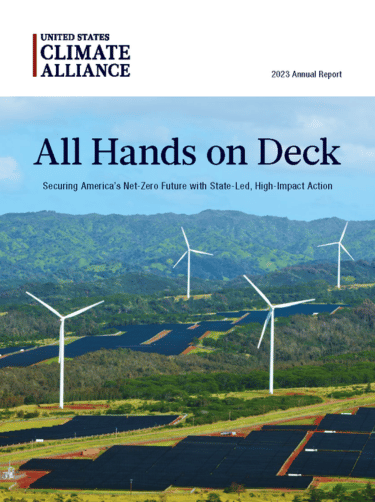Home / U.S. Climate Alliance Releases Annual Report, Finds Members on Track to Meet 2025 Emissions Reduction Goal

DUBAI, UAE – The U.S. Climate Alliance today released its annual report, All Hands on Deck: Securing America’s Net-Zero Future with State-Led, High-Impact Action, which includes new analysis showing that its 25 member states and territories — representing approximately 60% of the U.S. economy and 55% of the U.S. population — are now projected to reduce collective greenhouse gas (GHG) emissions 26% by 2025 below 2005 levels and achieve their near-term climate target.
“The climate crisis is here — and this is America’s all-hands-on-deck moment. Fortunately, from coast to coast, the U.S. Climate Alliance and our 25 governors are answering the call,” said the Alliance’s co-chairs Washington Gov. Jay Inslee and Maine Gov. Janet Mills in their Annual Report message. “The result of all this work is real progress for America.”
The findings were highlighted today in a new Alliance video and at an Alliance event yesterday at COP28 in Dubai, where Executive Director Casey Katims was joined by New Mexico Gov. Michelle Lujan Grisham, Maryland Environment Secretary Serena McIlwain, California Energy Commission Chair David Hochschild, and New Mexico Environment Secretary James Kenney, as well as White House National Climate Advisor Ali Zaidi. The report’s release comes as the global community convenes to take stock on progress toward fulfilling the Paris Agreement’s goals.
Additional key findings include:
Notably, these new projections significantly improve upon those released by the Alliance just two years ago and reflect the wave of ambitious state policies and historic federal funding and programs enacted since then.
Importantly, this analysis shows that investing in a net-zero future — including generating electricity from cleaner sources, increasing the energy efficiency of homes and businesses, and getting cleaner and more efficient vehicles on the road — is already producing significant benefits across Alliance states and territories. In fact, while continuing to reduce emissions, Alliance members grew their collective gross domestic product (GDP) by nearly 30% between 2005 and 2021. Additionally, compared to the rest of the country, Alliance members are:
The findings also indicate that the monetary benefits of transitioning to a net-zero economy will significantly outweigh the costs — generating hundreds of billions of dollars in savings through 2050 from improved public health, reduced fossil fuel spending, and avoided climate damages.
Finally, the report details many of the newest and most groundbreaking actions Alliance members have taken over the past year across 10 key policy areas — GHG targets and governance; buildings; climate finance; electricity generation; industry; just transition and equity; natural and working lands; pricing carbon and valuing damages; resilience; and transportation. Together, these actions are cutting emissions, safeguarding public health, and growing the economy.
The full Annual Report and Executive Summary can be read here. Analysis for this year’s Annual Report was conducted with support from America Is All In.
Launched in 2017 by the governors of Washington, New York, and California to help fill the void left by the U.S. federal government’s withdrawal from the Paris Agreement, the Alliance has grown to include 24 governors from across the U.S. representing approximately 60 percent of the U.S. economy and 55 percent of the U.S. population. Governors in the Alliance have pledged to collectively reduce net greenhouse gas emissions by at least 26-28 percent by 2025, 50-52 percent by 2030, and 61-66 percent by 2035, all below 2005 levels, and collectively achieve overall net-zero greenhouse gas emissions as soon as practicable, and no later than 2050.
The Alliance’s states and territories continue to advance innovative and impactful climate solutions to grow the economy, create jobs, and protect public health, and have a long record of action and results. In fact, the latest data shows that as of 2023, the Alliance has reduced its collective net greenhouse gas emissions by 24 percent below 2005 levels, while increasing collective GDP by 34 percent, and is on track to meet its near-term climate goal of reducing collective greenhouse gas emissions 26 percent below 2005 levels by 2025.
###